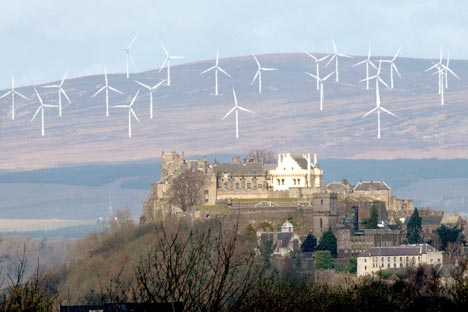| Wind Watch is a registered educational charity, founded in 2005. |
The shocking picture that shows how a wind farm has disfigured one of Britain's loveliest landscapes
Translate: FROM English | TO English
Translate: FROM English | TO English
During a long and bloody history, it has withstood more than a dozen sieges and held firm against the army of Bonnie Prince Charlie. But now Stirling Castle has been surrounded by a new, and very modern, army – of towering wind turbines.
This extraordinary picture shows a sprawling wind farm dramatically overshadowing the famous city where Mary, Queen of Scots was crowned in 1543.
Standing a staggering 328ft high, the 36 looming turbines dominate the skyline of the Braes O’Doune and have angered many local residents, who claim they have blighted one of Scotland’s classic vistas.

A price worth paying? The Braes O’Doune windfarm towers over Stirling Castle
And similar structures could soon be appearing in a field near you, as ugly onshore wind farms are thrown up to meet tough new European Union “green” electricity targets.
Critics say such wind farms are white elephants, claiming that they are both unreliable and inefficient.
The turbines turn only in wind speeds of at least 10mph and produce their maximum output only when winds reach 33mph.
As a result, they are idle for a fifth of the time and, in a typical year, work at just 30 per cent of their capacity. If winds drop, coal, gas and nuclear power stations have to meet the shortfall instantly.
In January, the Braes O’Doune farm generated 21,000 megawatt hours of electricity – around 39 per cent of its capacity. But during the summer months, when winds are lighter, that figure is expected to tumble.
The wind farm cost around £72million to build and it will take years before it starts making a profit. The private company which owns the farm can expect a return of between eight and 15 per cent on its investment.
Meanwhile, under the Government’s Renewable Obligations Certificates scheme, the cost of producing power from wind turbines is subsidised by every household via their electricity bills.
There are now 1,972 turbines in Britain, with a capacity of 2,400 megawatts, enough for 1.4 million homes. But under European proposals, 20 per cent of Britain’s electricity must come from sustainable sources by 2020.
That would require up to 20,000 new turbines on land and at sea – more than one every day between now and 2020.
Despite being the traditional gateway to the Highlands and a tourist hotspot, the area near Stirling is earmarked as a site for a flurry of new turbines as the Government attempts to meet these targets.
When it began producing electricity in February last year, former Trade and Industry Secretary Alistair Darling sang the praises of Braes O’Doune.

The site when it used to be surrounded only by dramatic – and empty – hills
As he opened the project, he said: “This is a major landmark. Over the last 20 months, we have doubled the amount of wind-generated electricity we have.”
But many locals are less than happy that the new “landmark” towers so intrusively above the old.
Campaigner John Digney, of the Scottish Wild Land Group, said: “There was a lot of opposition at the time, but the planning for this went through very quickly. People were genuinely shocked when they realised just how conspicuous it was.
“It is an eyesore. As you approach the city, this is your first glimpse of the Highlands and these turbines detract from the whole scene.
“It is not a pretty sight to find an industrialised development in one of the most stunning parts of the country – you can see the turbines from the William Wallace monument as well. It has been plonked on a fairly undistinguished section of moorland, but it’s the views of Stirling Castle that are ruined.”
Stirling Castle, which was home to Mary, Queen of Scots, is one of the largest and most important castles in Scotland.
Perched 250 feet up atop an extinct volcano, the castle was a favourite royal residence of the Stuart monarchs.
It also offers views over some of the country’s key battlefields, including Stirling Bridge, where William Wallace defeated the English in 1297, and Bannockburn, where Robert the Bruce dealt Scotland’s southern neighbours a similar blow in 1314.
It was last besieged in 1746, when Charles Edward Stuart, known as “Bonnie Prince Charlie”, tried unsuccessfully to seize the castle. Despite the criticism, the British Wind Energy Association has defended the location of the wind farm.
A spokesman said: “More than 150 jobs were created in constructing the turbines and they produce 72 megawatts – enough to supply electricity to 45,000 homes in the area.
“We don’t agree that the wind turbines are an eyesore, they are a feat of engineering and do not spoil the landscape. Wind energy will play a key role not only in mitigating the effect of climate change, but also in securing the energy future of this country.”
But as this picture shows, that “green” future may come at an extremely high price.
Elsewhere, Controversial plans for a massive wind farm on protected moorland were today rejected by the Scottish Government.
Ministers ruled that the proposals for Barvas Moor, Lewis, in the Western Isles were incompatible with European law.
The moor is designated under the EC Bird Directive and EC Habitats Directive.
Energy minister Jim Mather said he had considered the views of the local authority, the 10,924 objections and the 98 letters of support.
He said: “European legislation requires a specific procedure to be followed when proposals which could potentially affect Special Protection Areas come forward.
“I considered all the relevant issues and concluded it would not be possible to approve this application.
“The Lewis Wind Farm would have significant adverse impacts on the Lewis Peatlands Special Protection Area, which is designated due to its high value for rare and endangered birds.
“This decision does not mean that there cannot be onshore wind farms in the Western Isles.
“I strongly believe the vast renewables potential needs to be exploited to ensure that the opportunities and benefits of new development can be shared across the country in an equitable fashion.”
By Rebecca Camber and David Derbyshire
22 April 2008
This article is the work of the source indicated. Any opinions expressed in it are not necessarily those of National Wind Watch.
The copyright of this article resides with the author or publisher indicated. As part of its noncommercial educational effort to present the environmental, social, scientific, and economic issues of large-scale wind power development to a global audience seeking such information, National Wind Watch endeavors to observe “fair use” as provided for in section 107 of U.S. Copyright Law and similar “fair dealing” provisions of the copyright laws of other nations. Send requests to excerpt, general inquiries, and comments via e-mail.
| Wind Watch relies entirely on User Funding |
 (via Stripe) |
 (via Paypal) |
Share:

